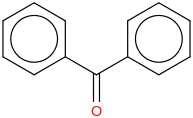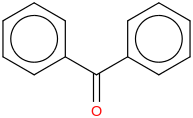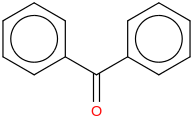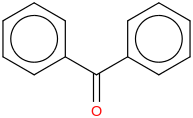Selected ATcT [1, 2] enthalpy of formation based on version 1.202 of the Thermochemical Network [3]This version of ATcT results[3] was generated by additional expansion of version 1.176 in order to include species related to the thermochemistry of glycine[4].
|
Benzophenone | | Formula: C6H5C(O)C6H5 (cr,l) | | CAS RN: 119-61-9 | | ATcT ID: 119-61-9*500 | | SMILES: c1ccccc1C(=O)c1ccccc1 | | SMILES: O=C(C=1C=CC=CC1)C=2C=CC=CC2 | | InChI: InChI=1S/C13H10O/c14-13(11-7-3-1-4-8-11)12-9-5-2-6-10-12/h1-10H | | InChIKey: RWCCWEUUXYIKHB-UHFFFAOYSA-N | | Hills Formula: C13H10O1 | 2D Image: |  | | Aliases: C6H5C(O)C6H5; Benzophenone; Diphenylmethanone; Benzoylbenzene; Diphenyl ketone; Adjutan 6016; B 0083; BLS 531; BP; Daracure 1137; Darocur BP; Gencure BP; Hycure Benzophenone; Irgacure BP; JRCure 1020; Kayacure BP; Kayacure BP 100; Lowlite 24; NSC 8077; Omnirad BP; Phenyl ketone; Photoinitiator BP; PI BP; Runtecure 1020; SB-PI 710; Speedcure BP; Winure BP; alpha-Oxodiphenylmethane; alpha-Oxoditane; OC(C6H5)2; (C6H5)2CO | | Relative Molecular Mass: 182.2179 ± 0.0104 |
| ΔfH°(0 K) | ΔfH°(298.15 K) | Uncertainty | Units |
|---|
| -16.7 | -41.9 | ± 1.5 | kJ/mol |
| Top contributors to the provenance of ΔfH° of C6H5C(O)C6H5 (cr,l)The 20 contributors listed below account only for 88.3% of the provenance of ΔfH° of C6H5C(O)C6H5 (cr,l).
A total of 24 contributors would be needed to account for 90% of the provenance.
Please note: The list is limited to 20 most important contributors or, if less, a number sufficient to account for 90% of the provenance. The Reference acts as a further link to the relevant references and notes for the measurement. The Measured Quantity is normaly given in the original units; in cases where we have reinterpreted the original measurement, the listed value may differ from that given by the authors. The quoted uncertainty is the a priori uncertainty used as input when constructing the initial Thermochemical Network, and corresponds either to the value proposed by the original authors or to our estimate; if an additional multiplier is given in parentheses immediately after the prior uncertainty, it corresponds to the factor by which the prior uncertainty needed to be multiplied during the ATcT analysis in order to make that particular measurement consistent with the prevailing knowledge contained in the Thermochemical Network.
| Contribution
(%) | TN
ID | Reaction | Measured Quantity | Reference | | 55.6 | 9445.1 | C6H5C(O)C6H5 (cr,l) + 15 O2 (g) → 13 CO2 (g) + 5 H2O (cr,l) | ΔrH°(298.15 K) = -6502.56 ± 1.92 kJ/mol | Verevkin 1998, note unc2 | | 3.8 | 9442.3 | C6H5C(O)C6H5 (g) + CH2O (g) → 2 C6H5C(O)H (g) | ΔrH°(0 K) = -2.52 ± 0.90 kcal/mol | Ruscic CBS-n | | 3.8 | 9442.1 | C6H5C(O)C6H5 (g) + CH2O (g) → 2 C6H5C(O)H (g) | ΔrH°(0 K) = -3.18 ± 0.90 kcal/mol | Ruscic G4 | | 3.3 | 9444.3 | C6H5C(O)C6H5 (g) + HCO (g) → C6H5CO (g) + C6H5C(O)H (g) | ΔrH°(0 K) = 0.28 ± 0.90 kcal/mol | Ruscic CBS-n | | 3.1 | 9445.2 | C6H5C(O)C6H5 (cr,l) + 15 O2 (g) → 13 CO2 (g) + 5 H2O (cr,l) | ΔrH°(298.15 K) = -1555.96 ± 0.50 (×3.83) kcal/mol | Colomina 1959 | | 3.1 | 9442.2 | C6H5C(O)C6H5 (g) + CH2O (g) → 2 C6H5C(O)H (g) | ΔrH°(0 K) = -3.20 ± 1.00 kcal/mol | Ruscic CBS-n | | 2.7 | 9444.2 | C6H5C(O)C6H5 (g) + HCO (g) → C6H5CO (g) + C6H5C(O)H (g) | ΔrH°(0 K) = -0.76 ± 1.00 kcal/mol | Ruscic CBS-n | | 2.0 | 9445.3 | C6H5C(O)C6H5 (cr,l) + 15 O2 (g) → 13 CO2 (g) + 5 H2O (cr,l) | ΔrH°(298.15 K) = -1556.47 ± 0.78 (×3.084) kcal/mol | Parks 1950a | | 1.5 | 9446.2 | C6H5C(O)C6H5 (cr,l) → C6H5C(O)C6H5 (g) | ΔrH°(306 K) = 22.2 ± 0.2 kcal/mol | van Ginkel 2001 | | 1.5 | 7256.1 | C6H5C(O)H (cr,l) + 8 O2 (g) → 7 CO2 (g) + 3 H2O (l) | ΔrH°(298.15 K) = -3524.94 ± 1.97 kJ/mol | Ambrose 1975b | | 1.3 | 7321.1 | CH3C6H4C(O)H (cr, l, ortho) + 19/2 O2 (g) → 8 CO2 (g) + 4 H2O (cr,l) | ΔrH°(298.15 K) = -4170.4 ± 2.1 kJ/mol | Bilodeau 1999 | | 1.1 | 9444.1 | C6H5C(O)C6H5 (g) + HCO (g) → C6H5CO (g) + C6H5C(O)H (g) | ΔrH°(0 K) = -2.12 ± 0.90 (×1.719) kcal/mol | Ruscic G4 | | 0.9 | 7291.1 | C6H5C(O)CH3 (cr,l) + 19/2 O2 (g) → 8 CO2 (g) + 4 H2O (cr,l) | ΔrH°(298.15 K) = -4148.80 ± 0.89 (×3.292) kJ/mol | Colomina 1961 | | 0.5 | 7279.1 | C6H5C(O)Cl (cr,l) → C6H5C(O)Cl (g) | ΔrH°(298.15 K) = 55.5 ± 1.8 (×1.795) kJ/mol | ThermoData 2004 | | 0.5 | 7260.5 | C6H5C(O)H (g) + CH3CH3 (g) → C6H5CH3 (g) + CH3CHO (g) | ΔrH°(0 K) = 1.25 ± 0.85 kcal/mol | Ruscic W1RO | | 0.5 | 7259.5 | C6H5C(O)H (g) + CH4 (g) → C6H5CH3 (g) + CH2O (g) | ΔrH°(0 K) = 12.45 ± 0.9 kcal/mol | Ruscic W1RO | | 0.5 | 7258.5 | C6H5C(O)H (g) + CH4 (g) → C6H6 (g) + CH3CHO (g) | ΔrH°(0 K) = 7.06 ± 0.9 kcal/mol | Ruscic W1RO | | 0.5 | 7260.4 | C6H5C(O)H (g) + CH3CH3 (g) → C6H5CH3 (g) + CH3CHO (g) | ΔrH°(0 K) = 1.58 ± 0.90 kcal/mol | Ruscic CBS-n | | 0.5 | 7260.2 | C6H5C(O)H (g) + CH3CH3 (g) → C6H5CH3 (g) + CH3CHO (g) | ΔrH°(0 K) = 1.20 ± 0.90 kcal/mol | Ruscic G4 | | 0.5 | 7260.1 | C6H5C(O)H (g) + CH3CH3 (g) → C6H5CH3 (g) + CH3CHO (g) | ΔrH°(0 K) = 1.59 ± 0.90 kcal/mol | Ruscic G3X |
| Top 10 species with enthalpies of formation correlated to the ΔfH° of C6H5C(O)C6H5 (cr,l) | Please note: The correlation coefficients are obtained by renormalizing the off-diagonal elements of the covariance matrix by the corresponding variances.
The correlation coefficient is a number from -1 to 1, with 1 representing perfectly correlated species, -1 representing perfectly anti-correlated species, and 0 representing perfectly uncorrelated species.
| Correlation
Coefficent
(%) | Species Name | Formula | Image | ΔfH°(0 K) | ΔfH°(298.15 K) | Uncertainty | Units | Relative
Molecular
Mass | ATcT ID | | 100.0 | Benzophenone | C6H5C(O)C6H5 (cr) |  | -16.7 | -41.9 | ± 1.5 | kJ/mol | 182.2179 ±
0.0104 | 119-61-9*510 | | 100.0 | Benzophenone | C6H5C(O)C6H5 (l) |  | | -24.8 | ± 1.5 | kJ/mol | 182.2179 ±
0.0104 | 119-61-9*590 | | 91.0 | Benzophenone | C6H5C(O)C6H5 (g) |  | 80.7 | 51.5 | ± 1.5 | kJ/mol | 182.2179 ±
0.0104 | 119-61-9*0 | | 45.9 | Benzaldehyde | C6H5C(O)H (g) |  | -19.16 | -36.95 | ± 0.68 | kJ/mol | 106.1219 ±
0.0056 | 100-52-7*0 | | 36.7 | Benzoyl | C6H5CO (g) | ![c1ccc(cc1)[C]=O](../images/204.png) | 138.85 | 125.32 | ± 0.98 | kJ/mol | 105.1140 ±
0.0056 | 2652-65-5*0 | | 31.3 | Acetophenone | C6H5C(O)CH3 (g) |  | -60.71 | -83.90 | ± 0.98 | kJ/mol | 120.1485 ±
0.0064 | 98-86-2*0 | | 29.2 | Acetophenone | C6H5C(O)CH3 (cr,l) |  | | -139.3 | ± 1.1 | kJ/mol | 120.1485 ±
0.0064 | 98-86-2*500 | | 29.0 | Benzaldehyde | C6H5C(O)H (cr,l) |  | -85.59 | -86.66 | ± 0.90 | kJ/mol | 106.1219 ±
0.0056 | 100-52-7*500 | | 26.0 | m-Tolualdehyde | CH3C6H4C(O)H (g, meta) |  | -48.4 | -71.3 | ± 1.2 | kJ/mol | 120.1485 ±
0.0064 | 620-23-5*0 | | 25.9 | p-Tolualdehyde | CH3C6H4C(O)H (g, para) |  | -49.2 | -72.2 | ± 1.2 | kJ/mol | 120.1485 ±
0.0064 | 104-87-0*0 |
| Most Influential reactions involving C6H5C(O)C6H5 (cr,l)Please note: The list, which is based on a hat (projection) matrix analysis, is limited to no more than 20 largest influences.
| Influence
Coefficient | TN
ID | Reaction | Measured Quantity | Reference | | 1.000 | 9448.1 | C6H5C(O)C6H5 (cr,l) → C6H5C(O)C6H5 (cr) | ΔrH°(298.15 K) = 0 ± 0 cm-1 | triv | | 0.568 | 9445.1 | C6H5C(O)C6H5 (cr,l) + 15 O2 (g) → 13 CO2 (g) + 5 H2O (cr,l) | ΔrH°(298.15 K) = -6502.56 ± 1.92 kJ/mol | Verevkin 1998, note unc2 | | 0.562 | 9446.2 | C6H5C(O)C6H5 (cr,l) → C6H5C(O)C6H5 (g) | ΔrH°(306 K) = 22.2 ± 0.2 kcal/mol | van Ginkel 2001 | | 0.090 | 9446.4 | C6H5C(O)C6H5 (cr,l) → C6H5C(O)C6H5 (g) | ΔrH°(321.03 K) = 94.7 ± 1 (×2.089) kJ/mol | de Kruif 1983 | | 0.090 | 9446.6 | C6H5C(O)C6H5 (cr,l) → C6H5C(O)C6H5 (g) | ΔrH°(308.15 K) = 22.44 ± 0.5 kcal/mol | de Kruif 1977, est unc | | 0.090 | 9446.5 | C6H5C(O)C6H5 (cr,l) → C6H5C(O)C6H5 (g) | ΔrH°(304 K) = 22.7 ± 0.5 kcal/mol | Colomina 1959, est unc | | 0.081 | 9446.1 | C6H5C(O)C6H5 (cr,l) → C6H5C(O)C6H5 (g) | ΔrH°(298.15 K) = 93.1 ± 2.2 kJ/mol | Verevkin 1998 | | 0.039 | 9446.3 | C6H5C(O)C6H5 (cr,l) → C6H5C(O)C6H5 (g) | ΔrH°(308 K) = 21.5 ± 0.5 (×1.509) kcal/mol | Stephenson 1987, est unc, as quoted by NIST WebBook | | 0.032 | 9445.2 | C6H5C(O)C6H5 (cr,l) + 15 O2 (g) → 13 CO2 (g) + 5 H2O (cr,l) | ΔrH°(298.15 K) = -1555.96 ± 0.50 (×3.83) kcal/mol | Colomina 1959 | | 0.020 | 9445.3 | C6H5C(O)C6H5 (cr,l) + 15 O2 (g) → 13 CO2 (g) + 5 H2O (cr,l) | ΔrH°(298.15 K) = -1556.47 ± 0.78 (×3.084) kcal/mol | Parks 1950a | | 0.004 | 9445.5 | C6H5C(O)C6H5 (cr,l) + 15 O2 (g) → 13 CO2 (g) + 5 H2O (cr,l) | ΔrH°(291.15 K) = -1555 ± 5 kcal/mol | Landrieu 1924, est unc | | 0.004 | 9445.4 | C6H5C(O)C6H5 (cr,l) + 15 O2 (g) → 13 CO2 (g) + 5 H2O (cr,l) | ΔrH°(291.15 K) = -1555.3 ± 5 kcal/mol | Burriel 1931, est unc, as quoted by NIST WebBook |
|
|
|
References
|
|
1
|
|
B. Ruscic, R. E. Pinzon, M. L. Morton, G. von Laszewski, S. Bittner, S. G. Nijsure, K. A. Amin, M. Minkoff, and A. F. Wagner,
Introduction to Active Thermochemical Tables: Several "Key" Enthalpies of Formation Revisited.
J. Phys. Chem. A 108, 9979-9997 (2004)
[DOI: 10.1021/jp047912y]
|
|
2
|
|
B. Ruscic, R. E. Pinzon, G. von Laszewski, D. Kodeboyina, A. Burcat, D. Leahy, D. Montoya, and A. F. Wagner,
Active Thermochemical Tables: Thermochemistry for the 21st Century.
J. Phys. Conf. Ser. 16, 561-570 (2005)
[DOI: 10.1088/1742-6596/16/1/078]
|
|
3
|
|
B. Ruscic and D. H. Bross,
Active Thermochemical Tables (ATcT) values based on ver. 1.202 of the Thermochemical Network (2024); available at ATcT.anl.gov |
|
4
|
|
B. Ruscic and D. H. Bross
Accurate and Reliable Thermochemistry by Data Analysis of Complex Thermochemical Networks using Active Thermochemical Tables: The Case of Glycine Thermochemistry
Faraday Discuss. (in press) (2024)
[DOI: 10.1039/D4FD00110A]
|
|
5
|
|
B. Ruscic,
Uncertainty Quantification in Thermochemistry, Benchmarking Electronic Structure Computations, and Active Thermochemical Tables.
Int. J. Quantum Chem. 114, 1097-1101 (2014)
[DOI: 10.1002/qua.24605]
|
|
6
|
|
B. Ruscic and D. H. Bross,
Thermochemistry
Computer Aided Chem. Eng. 45, 3-114 (2019)
[DOI: 10.1016/B978-0-444-64087-1.00001-2]
|
|
|
|
Formula
|
|
The aggregate state is given in parentheses following the formula, such as: g - gas-phase, cr - crystal, l - liquid, etc.
|
|
|
Uncertainties
|
The listed uncertainties correspond to estimated 95% confidence limits, as customary in thermochemistry (see, for example, Ruscic [5] and Ruscic and Bross[6]).
Note that an uncertainty of ± 0.000 kJ/mol indicates that the estimated uncertainty is < ± 0.0005 kJ/mol.
|
|
|
Website Functionality Credits
|
The reorganization of the website was developed and implemented by David H. Bross (ANL).
The find function is based on the complete Species Dictionary entries for the appropriate version of the ATcT TN.
The molecule images are rendered by Indigo-depict.
The XYZ renderings are based on Jmol: an open-source Java viewer for chemical structures in 3D. http://www.jmol.org/.
|
|
|
Acknowledgement
|
|
This work was supported by the U.S. Department of Energy, Office of Science, Office of Basic Energy Sciences, Division of Chemical Sciences, Geosciences and Biosciences under Contract No. DE-AC02-06CH11357.
|
|
Page generated: 04/09/2025
|







